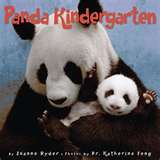 If you’re craving engaging nonfiction to share with early elementary students, I have a book that will satisfy the pickiest readers: From Cocoa Bean to Chocolate by Robin Nelson. It is arguably the yummiest title in the “Start to Finish” series by Lerner (although From Milk to Ice Cream sounds pretty good, too!) Simple sentences tell how cocoa beans are made into candy. I love that each page has basic information in bold letters (“Cocoa beans grow”) and then a few short sentences with more information (“A farmer plants many cocoa trees. Hard pods grow on each tree. Inside each pod are seeds called cocoa beans.”) So if you’re reading to the very young, or those with very short attention spans, you can read just the bold sentences, but you have enough information to share with those who are ready for longer text. Great full-page photos make this book easy to share with a large group. Informational text features like a table of contents, an index, and a glossary make this a delicious introduction to nonfiction.
If you’re craving engaging nonfiction to share with early elementary students, I have a book that will satisfy the pickiest readers: From Cocoa Bean to Chocolate by Robin Nelson. It is arguably the yummiest title in the “Start to Finish” series by Lerner (although From Milk to Ice Cream sounds pretty good, too!) Simple sentences tell how cocoa beans are made into candy. I love that each page has basic information in bold letters (“Cocoa beans grow”) and then a few short sentences with more information (“A farmer plants many cocoa trees. Hard pods grow on each tree. Inside each pod are seeds called cocoa beans.”) So if you’re reading to the very young, or those with very short attention spans, you can read just the bold sentences, but you have enough information to share with those who are ready for longer text. Great full-page photos make this book easy to share with a large group. Informational text features like a table of contents, an index, and a glossary make this a delicious introduction to nonfiction.
From Cocoa Bean to Chocolate is terrific to address the Common Core State Standard of Key Ideas and Details in Reading. With your students, use the book to help write out the steps in the cocoa-to-chocolate process on index cards. Students can then shuffle the cards and order the steps correctly on a bulletin board, or you can hang a clothesline for students to pin the steps in order. Include as few or as many steps as suits your class needs. If you have the means, bring in cocoa beans for your students to see and taste (they are a bit pricey, but I found an 8-ounce bag online for less than $10). To incorporate math and graphing skills, taste-test types of chocolate (dark vs. milk, etc.) and graph favorites. From Cocoa Bean to Chocolate makes informational reading sweet!



